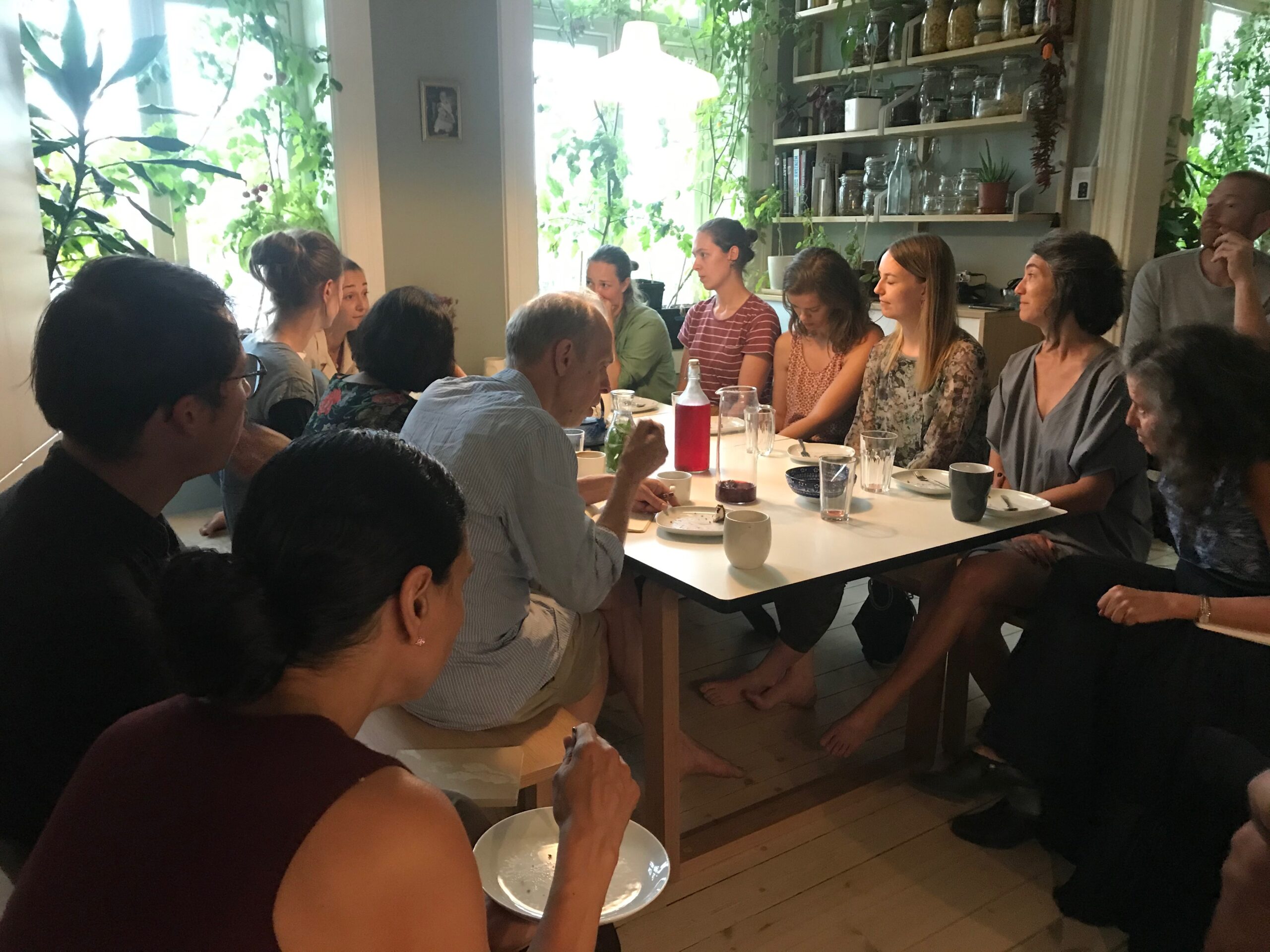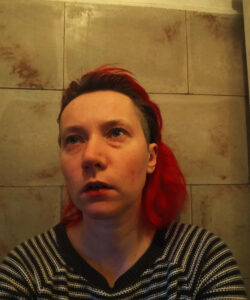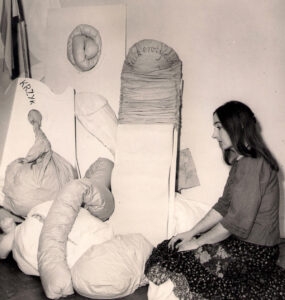Martinka Bobrikova

born in 1981 in Bratislava – graduated from the master’s programme at Malmö Art Academy – Lund University in Malmö (Sweden). She did her Bachelor’s degree at Universidad de La Laguna/ Facultad de Bellas Artes in Santa Cruz de Tenerife (Spain) and at Accademia di Belle Arti di Roma in Rome (Italy). Since 2005 she has been collaborating with Oscar de Carmen, with whom she founded the Nomad AiR (Nomadic Artist in Residence Program) and Anti Symposium projects. In addition, they are cofounders of The Union and the Future Utopia Community Key in addition to exhibiting worldwide. Martinka lives in Oslo and Bratislava.
Since 2005, I have been working with Oscar de Carmen. Our practice is closely connected to and deeply rooted in our lives. It stems from everyday life, from objects around us, from events we experience in this age we live in, as well as from our personal interests. Whether we want to define our practice as artistic or not is irrelevant. We are people, citizens, neighbours, family, friends first and foremost…and then perhaps artists too. Our first collaboration developed as part of a university summer exhibition in Spain, where we studied. We created a video called Constructive Critique for Young Artists, which joked about the exhibition format and the meaning it had for the students.
The topics we work with choose us, not the other way around. They are part of our life and everyday reality, our struggles, and are a part of our local context. We are driven by a curiosity to discover and rediscover our environment not only to bring us new knowledge, but to understand how our surroundings inform how we behave, how we perceive art, power dynamics within society, and economics. As an artistic duo, we focus on methods of exhibiting art and strategies of self-curation, self-organisation, self-publication and self-representation. This practice is based on a desire to understand our relationship to cultural institutions and the way art and cultural organisations operate. We understand these spaces to be hierarchical and not open or horizontal enough.
After finishing our studies in Sweden in 2012, we spent a few years traveling from residency to residency. This allowed us to survive as well as build our portfolio. During this time, we created Superflous Identity56 and Living in the Beginning of Times1234 – projects that had multiple site-specific and context-specific outputs. However, we had no way of storing these outputs and it wouldn’t have made sense to exhibit them elsewhere again, since they are tied to in a given place, context and audience. After the exhibition we would therefore “destroy” these works and use the materials in other projects. In every new work, the remains of the previous one are visible; it is the natural development of both the work and our practice. We started documenting the entire process and published small-scale publications that extended the life of these works that no longer physically existed.
One of the topics we have been working with since the beginning is food. We enjoy eating and we enjoy sharing food with others. But food needs to be procured and prepared. This led us to a plethora of related themes and is how the Kitchen Dialogues789 came to be – a project that was a continuation of what we had been doing for many years without defining it in terms of art. Back in Spain, our student flat was always full of people, friends and fellow students. We lived only three minutes away from the university, there was always food ready, or it was being prepared, and there was never a shortage of wine. We would meet, we would talk, we would help each other and we trusted each other… In Kitchen Dialogues, we created a special bond with each participant that, in many cases, grew into a long-lasting friendship. Because this type of project, like many others, is mostly about participation, it is not possible to exhibit or document it in any coherent way. The book form is the only possible output that allows those who did not manage to participate grasp the idea too.
We are not looking for short term residencies at the moment. Rather, Oscar and I are thinking long-term and we continue to focus on the local context. We have a need to stay longer and take root. Because of this, we no longer take part in the typical residencies run by large institutions, but rather we participate in projects run by artists, like us, with similar values and approaches. At a certain point we found the material work unsustainable and we started to focus more and more on creating situational and relational projects. These projects often use tools such as curating, establishing residencies (NomadAiR, Future Utopia Community Key)1617, artist-run spaces and projects (The Union)18, organising festivals and symposia (Anti-Symposium)131415. The most important part is always the idea, its execution; the medium is completely irrelevant for us.
One of the key tools I use is language – not only in verbal or acoustic expression, but also in the form of body language and movement. I am fascinated with getting to know new languages and I speak six myself. With each language, one becomes a distinct individual, a new persona. As the name suggests, The Migrant Assembly1112 project has a double meaning – we play with the words migrant and migrating (project and assembly). This makes it more complex and at the same time it gives us the opportunity to travel with the project to the places of the migrant-locals and work with them in their context. I don’t consider myself a migrant but a European and a citizen of the world. I feel that I can find my place and feel at home everywhere. Every place is made up of its people after all.
I have an adventurous nature; I constantly need stimuli, inspiration. I am interested in everyone and everything, but only some of it fascinates me. It was by chance that I ended up in Norway, and it’s by chance that after all these years I still live and work here. I think of Slovakia as one of the many countries I love and where I like returning to. There are many people there whom I greatly respect, both for their work as well as personally, which is why I enjoy working with many of them.
The text was written in collaboration with Miroslava Urbanová (2022).
1Image: Bobrikova & de Carmen, Photogeny of a contextualization for a new revolution / LIVING IN THE BEGINNING OF TIMES 59.923885, 10.758991 / 10.17, 2017, Ram Galleri, Oslo, photo: Jan Khür, see: bobrikovadecarmen.org/installation/living-in-the-beginning-of-times-59-923885-10-758991-10-17/.2Image: Bobrikova & de Carmen, LIVING IN THE BEGINNING OF TIMES 59.923885, 10.758991 / 10.17, 2017, Ram Galleri, Oslo, photo: Jan Khür, see: bobrikovadecarmen.org/installation/living-in-the-beginning-of-times-59-923885-10-758991-10-17/.
3Image: Bobrikova & de Carmen, LIVING IN THE BEGINNING OF TIMES, 2017, Skiens Konstforening, Skien, photo: OLE MORTEN EYRA, see: bobrikovadecarmen.org/installation/living-in-the-beginning-of-times/.
4Image: Bobrikova & de Carmen, LIVING IN THE BEGINNING OF TIMES 50.660940, 14.007270 / 12.19, 2019, Galerie Emila Filly, Usti and Labem, photo: Jirka Dvořák, see: bobrikovadecarmen.org/installation/living-in-the-beginning-of-times-50-660940-14-007270-12-19/.
5Image: Bobrikova & de Carmen, SUPERFLUOUS IDENTITY III, 2015, Galerie Entrance, Praha, photo: Martin Bražina, see: bobrikovadecarmen.org/installation/superfluous-identity-iii-2/.
6Image: Bobrikova & de Carmen, SUPERFLUOUS IDENTITY IV, 2015, Babel, Trondheim, photo: courtesy of the artists, see: bobrikovadecarmen.org/installation/superfluous-identity-iv-2/.
7Image: Bobrikova & de Carmen, Kitchen Dialogues, performative non lecture, 2013, Kunstnernes Hus, Oslo, photo: Magnus Trevisan, see: bobrikovadecarmen.org/product/kitchen-dialogues-book-shop/.
8Image: Bobrikova & de Carmen, Kitchen Dialogues, 2014, Nida Art Colony, Nida, Ernest_Truely, see: bobrikovadecarmen.org/news/kitchen-dialogues-book/.
9Image: Bobrikova & de Carmen, Kitchen Dialogues, Artists Menu, 2016, Cafe Berlinka, Bratislava / in collaboration with Transit.sk, photo: Adam Šakový, see: bobrikovadecarmen.org/performance/artist-menu/.
10Image: Bobrikova & de Carmen, Outsider in the north, Outsider, 2018, Kunst Vardo, Oslo, photo: Linnea MF Larsson, see: vimeo.com/manage/videos/306227709.
11Image: Bobrikova & de Carmen, The Migrant Assembly 1, PARTICIPATORY IMAGINARIES FOR REST AND THE FUTURE OF RETIREMENT hosted by Verdensrommet, Outsider, 2021, public space, Oslo, photo: Jacky Jaan-Yuan Kuo, see: themigrantassembly.org/assembly-1/.
12Image: Bobrikova & de Carmen, The Migrant Assembly 2, hosted by “Reunión”, a project by Dani Zelko, Outsider, 2021, public space, Oslo, photo: Jacky Jaan-Yuan Kuo, see: themigrantassembly.org/assembly-2/, video: themigrantassembly.org/assembly-3-timelapse/.
13Image: Bobrikova & de Carmen, Anti-symposium, 2019, Udebbo, Sweden, photo: Antti Ahonen, see: anti-symposium.org/2019.
14Image: Bobrikova & de Carmen, Anti-symposium, 2019, Udebbo, Sweden, photo: Antti Ahonen, see: anti-symposium.org/2019.
15Image: Bobrikova & de Carmen, Anti-symposium, 2019, Udebbo, Sweden, photo: Antti Ahonen, see: anti-symposium.org/2019.
16Image: Future Utopia Community Key, artist in residency program, Elia Nurvista, 2019, Udebbo, Sweden, photo: courtesy of the artists, see: futureutopiacommunitykey.org.
17Image: Bobrikova & de Carmen, NomadAir, resident: Anto Lloveras, 2016, Vienna, Austria, photo: courtesy of the artists, see: nomadair.org.
18Image:The Union, The Common LivingRoom Chapter: Windows Views, ep #3 “artists vs. Non-artists Talks” w. Yola Maria Tsolis, 2020, Oslo Norway, photo: courtesy of the artists, see: theunion.no.
– sa narodila v roku 1981 v Bratislave – absolvovala magisterské štúdium na Malmö Art Academy – Lund University v Malmö (Švédsko). Bakalársky stupeň študovala na Universidad de La Laguna/ Facultad de Bellas Artes v Santa Cruz de Tenerife (Španielsko) a na Accademia di Belle Arti di Roma v Ríme (Taliansko). Od roku 2005 spolupracuje so španielskym umelcom Oscarom de Carmenom, s ktorým založili programy Nomad AiR (Nomadic Artist in Residence Program) a Anti-Symposium. Sú spoluzakladateľmi programov The Union či Future Utopia Community Key. Vystavujú celosvetovo.
Žije v Osle a v Bratislave.
Od roku 2005 spolupracujem s Oscarom de Carmenom. Naša prax je úzko spojená a zakorenená v našom živote. Vychádza z každodenného života, z vecí ktoré sú okolo nás, z udalostí, ktoré zažívame alebo sme ich súčasťou v dobe, v ktorej žijeme, ako aj z osobných záujmov. Či už túto prax chceme definovať ako umeleckú alebo nie, nie je vôbec relevantné. Sme v prvom rade ľuďmi, občanmi, susedmi, rodinou, kamarátmi … a možno aj umelcami. Naša prvá spolupráca vznikla v rámci letného prieskumu v Španielsku, kde sme študovali. Vytvorili sme video Constructive Critique for Young Artists (Konštruktívna kritika pre mladých umelcov), v ktorom sme si uťahovali z prieskumu ako formy výstavy a jej významu pre samotných študentov.
Témy, s ktorými pracujeme, si vyberajú nás a nie my ich. Sú súčasťou nášho života a každodennej reality, našich bojov, miestneho kontextu. Zvedavosť neustále spoznávať a znovu-poznávať okolie a jej aktérov nám prináša nielen nové vedomosti, ale aj to, ako dnes konáme, ako vnímame umenie, moc a ekonomiku. Ako umelecké duo sa zaoberáme výstavnými postupmi a stratégiami sebakurátorovania, sebaorganizácie, sebapublikovania a seba(re)prezentácie. Táto prax vychádza z nášho vzťahu k inštitúciám, k spôsobu fungovania umeleckých a kultúrnych inštitúcií, ktorý je podľa nás ešte stále veľmi hierarchizovaný a nie príliš otvorený a horizontálny.
Po skončení štúdia vo Švédsku v roku 2012 sme niekoľko rokov cestovali z rezidencie na rezidenciu. Umožnilo nám to prežiť a zároveň vytvoriť dielo, mať portfólio. Vznikli projekty ako Superflous Identity (Zbytočná identita)56 alebo Living in the Beginning of Times (Život na počiatku vekov)1234, ktoré mali viacero rôznych miestne špecifických a kontextuálne špecifických výstupov. Tieto výstupy sme však nemali ako uskladniť a ani by to nemalo zmysel ich znovu niekde vystaviť, keďže dávali zmysel len na danom mieste, v danom kontexte a pre dané publikum. Takže sme ich po výstave vždy „zničili“ a využili materiál pre ďalší projekt. V každom novom diele je vidno pozostatky predošlého, je to prirodzený vývoj ako diela, tak našej praxe. Celý proces sme začali dokumentovať a vydávať menšie publikácie, ktoré predĺžili život už neexistujúcemu dielu.
Jednou z tém, ktorým sa venujeme od začiatku, je jedlo. Chutí nám jesť a deliť sa o jedlo s ľuďmi. Jedlo treba však aj zohnať a pripraviť. A hneď natrafíte na nespočetné množstvo tém, ktoré sa s tým spájajú. Takto vznikol aj projekt Kitchen Dialogues (Kuchynské rozhovory)789, ktorý bol pokračovaním toho, čo sme už dlhé roky robili bez toho, aby sme to definovali pojmom umenie. Už v Španielsku bol náš študentský byt vždy plný ľudí z kamarátskych a školských kruhov. Bývali sme iba tri minúty od školy, vždy bolo u nás navarené alebo sa práve varilo, nechýbalo víno. Stretávali sme sa, rozprávali, pomáhali sme si a dôverovali sme si… V projekte Kitchen Dialogues si vytvárame s každým účastníkom osobitné puto, ktoré vo viacerých prípadoch prerástlo do dlhoročného priateľstva. Keďže je tento typ projektu, ako aj mnohé iné, prevažne o participácii, nie je možné ho vystaviť a ani nijakým spôsobom koherentne zdokumentovať. Knižná forma je jediným možným výstupom, aby aj tí, ktorým sa nepodarilo zúčastniť sa, mohli projekt uchopiť.
Krátkodobé rezidencie v súčasnosti nevyhľadávame. S Oscarom skôr uvažujeme dlhodobo a zameriavame sa na miestny kontext, musíme zostať na jednom mieste dlhšie a zakoreniť. Preto už väčšinou nechodíme na klasické rezidencie, ktoré prevádzkujú veľké inštitúcie, ale skôr sa zúčastňujeme projektov prevádzkovaných umelcami ako my, s podobnou životnou filozofiou a prístupmi. V istom momente nám fyzické dielo prišlo neekologické a začali sme sa viac a viac venovať vytváraniu situačných vzťahových projektov. Tieto projekty často využívajú nástroje ako kurátorovanie, zakladanie rezidencií (NomadAiR, Future Utopia Community Key)1617, artist-run priestory a projekty (The Union)18, organizovanie festivalov a sympózií (Anti-Symposium)131415. Najdôležitejšia je vždy idea, jej prevedenie, médium je pre nás úplne irelevantné.
Jedným z kľúčových nástrojov je pre mňa jazyk, a to nielen vo verbálnom či akustickom prejave, ale aj v podobe reči tela a pohybu. Fascinuje ma spoznávanie nových rečí, sama hovorím šiestimi jazykmi. Pri každej reči sa človek stáva osobitou individualitou, novou persónou. Ako už samotný názov napovedá, projekt The Migrant Assembly/ Migrantské zhromaždenie1112 ma dvojitý zmysel, hráme sa so slovami migrant a migrujúci (projekt a zhromaždenie). Čiže je to o niečo komplexnejšie a zároveň nám to dáva možnosť sa s projektom pohybovať na miestach migrantov-miestnych a pracovať s nimi v ich kontexte. Ja sama sa necítim ako migrantka, ale ako Európanka a svetoobčanka. Mám pocit, že všade si viem nájsť svoje miesto a cítiť sa doma. Každé miesto je predsa len tvorené ľuďmi.
Som dobrodružná povaha, potrebujem konštantne nové podnety, inšpiráciu. Zaujímajú ma všetci a všetko, ale iba niečo fascinuje. Do Nórska som sa dostala náhodou a tak isto je náhoda, že tam po toľkých rokoch ešte stále žijem a pôsobím. Na Slovensko sa pozerám ako na jednu z množstva krajín, ktoré mám rada a kam sa rada vraciam. Je tu veľa ľudí, ktorých si veľmi vážim pre ich prácu ako aj pre ich ľudský rozmer a preto s mnohými z nich rada spolupracujem.
Text bol napísaný v spolupráci s Miroslavou Urbanovou (2022).
1Obrázok: Bobrikova & de Carmen, Photogeny of a contextualization for a new revolution / LIVING IN THE BEGINNING OF TIMES 59.923885, 10.758991 / 10.17, 2017, Ram Galleri, Oslo, foto: Jan Khür, viď: bobrikovadecarmen.org/installation/living-in-the-beginning-of-times-59-923885-10-758991-10-17/.2Obrázok: Bobrikova & de Carmen, LIVING IN THE BEGINNING OF TIMES 59.923885, 10.758991 / 10.17, 2017, Ram Galleri, Oslo, foto: Jan Khür, viď: bobrikovadecarmen.org/installation/living-in-the-beginning-of-times-59-923885-10-758991-10-17/.
3Obrázok: Bobrikova & de Carmen, LIVING IN THE BEGINNING OF TIMES, 2017, Skiens Konstforening, Skien, foto: OLE MORTEN EYRA, viď: bobrikovadecarmen.org/installation/living-in-the-beginning-of-times/.
4Obrázok: Bobrikova & de Carmen, LIVING IN THE BEGINNING OF TIMES 50.660940, 14.007270 / 12.19, 2019, Galerie Emila Filly, Usti and Labem, foto: Jirka Dvořák, viď: bobrikovadecarmen.org/installation/living-in-the-beginning-of-times-50-660940-14-007270-12-19/.
5Obrázok: Bobrikova & de Carmen, SUPERFLUOUS IDENTITY III, 2015, Galerie Entrance, Praha, foto: Martin Bražina, viď: bobrikovadecarmen.org/installation/superfluous-identity-iii-2/.
6Obrázok: Bobrikova & de Carmen, SUPERFLUOUS IDENTITY IV, 2015, Babel, Trondheim, foto: s láskavým dovolením umelkyne, see: bobrikovadecarmen.org/installation/superfluous-identity-iv-2/.
7Obrázok: Bobrikova & de Carmen, Kitchen Dialogues, performative non lecture, 2013, Kunstnernes Hus, Oslo, foto: Magnus Trevisan, viď: bobrikovadecarmen.org/product/kitchen-dialogues-book-shop/.
8Obrázok: Bobrikova & de Carmen, Kitchen Dialogues, 2014, Nida Art Colony, Nida, Ernest_Truely, viď: bobrikovadecarmen.org/news/kitchen-dialogues-book/.
9Obrázok: Bobrikova & de Carmen, Kitchen Dialogues, Artists Menu, 2016, Cafe Berlinka, Bratislava / v spolupráci s Transit.sk, foto: Adam Šakový, viď: bobrikovadecarmen.org/performance/artist-menu/.
10Obrázok: Bobrikova & de Carmen, Outsider in the north, Outsider, 2018, Kunst Vardo, Oslo, foto: Linnea MF Larsson, viď: vimeo.com/manage/videos/306227709.
11Obrázok: Bobrikova & de Carmen, The Migrant Assembly 1, PARTICIPATORY IMAGINARIES FOR REST AND THE FUTURE OF RETIREMENT hosted by Verdensrommet, Outsider, 2021, public space, Oslo, foto: Jacky Jaan-Yuan Kuo, see: themigrantassembly.org/assembly-1/.
12Obrázok: Bobrikova & de Carmen, The Migrant Assembly 2, hosted by “Reunión”, a project by Dani Zelko, Outsider, 2021, verejný priestor, Oslo, foto: Jacky Jaan-Yuan Kuo, see: themigrantassembly.org/assembly-2/, video: themigrantassembly.org/assembly-3-timelapse/.
13Obrázok: Bobrikova & de Carmen, Anti-symposium, 2019, Udebbo, Sweden, foto: Antti Ahonen, viď: anti-symposium.org/2019.
14Obrázok: Bobrikova & de Carmen, Anti-symposium, 2019, Udebbo, Sweden, foto: Antti Ahonen, viď: anti-symposium.org/2019.
15Obrázok: Bobrikova & de Carmen, Anti-symposium, 2019, Udebbo, Sweden, foto: Antti Ahonen, viď: anti-symposium.org/2019.
16Obrázok: Future Utopia Community Key, artist in residency program, Elia Nurvista, 2019, Udebbo, Sweden, foto: s láskavým dovolením umelkyne, viď: futureutopiacommunitykey.org.
17Obrázok: Bobrikova & de Carmen, NomadAir, resident: Anto Lloveras, 2016, Vienna, Austria, foto: s láskavým dovolením umelkyne, see: nomadair.org.
18Obrázok: The Union, The Common LivingRoom Chapter: Windows Views, ep #3 “artists vs. Non-artists Talks” w. Yola Maria Tsolis, 2020, Oslo Norway, foto: s láskavým dovolením umelkyne, viď: theunion.no.


